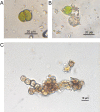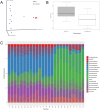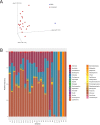Characterization of black patina from the Tiber River embankments using Next-Generation Sequencing
- PMID: 31917800
- PMCID: PMC6952188
- DOI: 10.1371/journal.pone.0227639
Characterization of black patina from the Tiber River embankments using Next-Generation Sequencing
Abstract
Black patinas are very common biological deterioration phenomena on lapideous artworks in outdoor environments. These substrates, exposed to sunlight, and atmospheric and environmental agents (i.e. wind and temperature changes), represent extreme environments that can only be colonized by highly versatile and adaptable microorganisms. Black patinas comprise a wide variety of microorganisms, but the morphological plasticity of most of these microorganisms hinders their identification by optical microscopy. This study used Next-Generation Sequencing (NGS) (including shotgun and amplicon sequencing) to characterize the black patina of the travertine embankments (muraglioni) of the Tiber River in Rome (Italy). Overall, the sequencing highlighted the rich diversity of bacterial and fungal communities and allowed the identification of more than one hundred taxa. NGS confirmed the relevance of coccoid and filamentous cyanobacteria observed by optical microscopy and revealed an informative landscape of the fungal community underlining the presence of microcolonial fungi and phylloplane yeasts. For the first time high-throughput sequencing allowed the exploration of the expansive diversity of bacteria in black patina, which has so far been overlooked in routine analyses. Furthermore, the identification of euendolithic microorganisms and weathering agents underlines the biodegradative role of black patina, which has often been underestimated. Therefore, the use of NGS to characterize black patinas could be useful in choosing appropriate conservation treatments and in the monitoring of stone colonization after the restoration interventions.
Conflict of interest statement
The authors have declared that no competing interests exist.
Figures








References
-
- Krumbein WE. Pinta and Patina–How Microbes change Surfaces. Geomicrobiol—Geomicrobiol ICBM Univ Oldenbg; 1997;
-
- Dong H, Rech JA, Jiang H, Sun H, Buck BJ. Endolithnic cyanobacteria in soil gypsum: Occurences in Atacama (Chile), Mojave (United States), and Al-Jafr Basin (Jordan) Deserts. J Geophys Res Biogeosciences. 2007;112: 1–11. 10.1029/2006JG000385 - DOI
-
- McNamara C, Perry TD, Zinn M, Breuker M, Muller R, Hernandez-Duque G, et al. Microbial Processes in the Deterioration of Maya Archaeological Buildings in Southern Mexico Art, Biology, and Conservation: Biodeterioration of Works of Art. New York: The Metropolitan Museum of Art; 2003. pp. 248–265.
-
- Golubić S, Pietrini A, Ricci S. Euendolithic activity of the cyanobacterium Chroococcus lithophilus Erc. in biodeterioration of the pyramid of Caius Cestius, Rome, Italy. Int Biodeterior Biodegradation. 2015;100: 7–16. Available: https://www.sciencedirect.com/science/article/pii/S0964830515000311
MeSH terms
LinkOut - more resources
Full Text Sources

